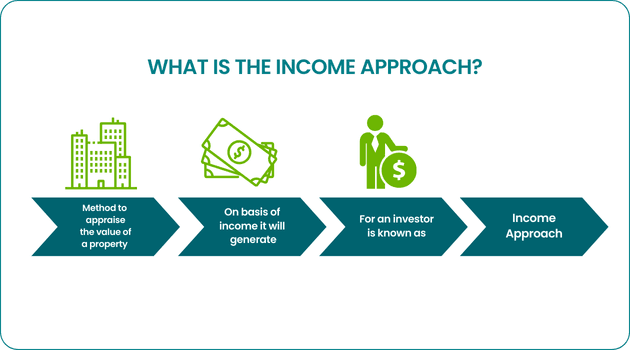Table Of Contents
What Is The Income Approach?
The income approach defines the method to appraise the value of a property based on the income it will generate for the investor, investing in real estate property. Investors use this method to evaluate and estimate their current returns and future gains when they decide to sell the property.

The income approach in real estate is the most important determinant for an investor, albeit it is difficult to estimate. The income generated from a property through rent should be higher than its operating expenses, i.e., repair and maintenance costs. Therefore, it reflects a profitable investment and secures an investor and lender in case of a mortgage.
Key Takeaways
- The income approach is a method to determine the valuation of a property based on its current value and capitalization rate when compared with similar properties.
- It allows an investor to determine their income returns and, at the same time, calculate their expenses, such as repair and maintenance costs.
- The income approach is determined by dividing net operating income (NOI) by the capitalization rate.
- However, it isn't easy to estimate the income generated from a property due to factors like age, functionality, or developments in and around it that may bring variations in investor returns.
Income Approach In Real Estate Explained
The income approach valuation is the most important indicator of remunerations for an investor compared to the other two, the costs approach or comparison approach. In effect, the comparison or direct comparison approach involves comparing the recent sales of similar properties to estimate and determine the value of a property in consideration. For example, this approach helps to determine the value of condos, residential apartments, or vacant areas and lands.
On the other side, the cost approach is helpful when determining the valuation of any property or what the buyer pays by adding land cost and construction cost. Thus, the comparison and income approach formula are not helpful in such a scenario.
The income approach valuation, also known as the capitalization approach, includes the cost incurred by the investor on an asset through repair and maintenance works. Thus, to calculate the capitalization rate, one should divide the net operating income (NOI) by the current asset value. In this case of income approach valuation, the asset is the property.
The capitalization rate represents the percentage of the investor's current total gains or rate of return on investments. The real estate income approach uses the capitalization rate to determine the actual earnings of the investor post-incurring expenses or costs. Thus, the income approach formula divides the net operating income (NOI) by the capitalization rate.
However, the income approach valuation of a property may change from time to time. It is because an investor should not only refer to the current capitalization or net operating income approach but also consider other factors. For example, this valuation will change due to discounted cash flow, as the property's value might increase with improving economic conditions around the property. Thus, in such a scenario, the investors' returns shall increase in the future.
Example
Let us look at an income approach example and its practical implications for an investor:
Mike is a real estate investor looking to purchase a house for living and rental purposes. He looks for a posh area that working professionals populate. However, before investing, Mike wants to determine the asset value and its returns. Thus, he finds the net operating income (NOI) for similar properties and their capitalization rate. This variable will also help him determine his current rate of return on this investment.
Knowing the capitalization rate (net operating cost divided by asset value) is also necessary to gain the lender's assurance in the case of a mortgage. Similarly, if the property requires repair, maintenance, or upgradation, these costs should be estimated beforehand to avoid reduced earnings.
Additionally, to maximize his returns and earnings, Mike should ensure that all units for rental purposes remain occupied. Otherwise, this investment will yield a poor net income for Mike and lower his returns when calculated through the income approach.
Thus, if a three-bedroom apartment has a capitalization rate of 11% and a net operating cost of $1,000,000, it will have a valuation of $9.09 million per the income approach.
However, the valuation of the property through the real estate income approach might change over time. Thus, as an investor, Mike should also consider other factors to evaluate his net returns from property investment. Such as economic factors or future infrastructure and civic amenities that might develop around the property.
Income Approach vs Cost Approach
The income and cost approaches are real estate valuation methods that assist investors in evaluating their returns. However, there are some significant differences between the two approaches.
The income approach focuses on the property type to determine the investor's revenue based on its current value. Thus, to determine the returns from the property in the short term, variables such as capitalization rate and net operating income are first determined for similar properties to estimate the income returns.
Simultaneously, the relationship between the operating income and a property's sale price help determine the capitalization rate. It is deduced by dividing net operating income by property purchase value. Examples of such properties are condos or apartments, as an investor or buyer can easily compare such similar properties.
On the other hand, in the costs approach, one cannot determine the property's value through comparison. It is because of the property's distinct, unique, and rare characteristics. For example, building a warehouse or industrial property for a specific purpose. Thus, the cost approach method determines a property's value by adding the cost of the land and the cost of building a new unit or reconstructing an old one.
In reconstructing an old building, income foregone such as taxes that the existing building attracts, will be added as cost. These variables help determine the true value and price of the property. Additionally, the final cost excludes the depreciation or adjustment costs from the cost of the property. The depreciation costs may occur due to a property's age, functionality, and economic conditions.
Thus, the income approach reflects investors' expectations and behaviors in a property market due to readily available market data on such properties.

